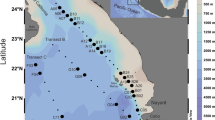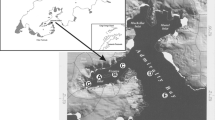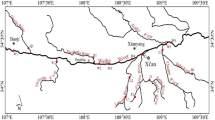Abstract
Traditionally, composition and biomass of phytoplankton communities are determined by microscopy, but this method is time-consuming and so does not allow for high-frequency data acquisition across space and time. Pigment-based chemotaxonomy (CHEMTAX) is now widely applied to study of phytoplankton community structure on broader spatial and temporal scales of oceans, but the ability of this approach to provide estimates of phytoplankton assemblage in freshwater ecosystems is yet underdeveloped. To investigate the efficiency of the high-performance liquid chromatography (HPLC)-CHEMTAX in quantifying the different phytoplankton groups in inland freshwater, we present a comparison between phytoplankton pigment analyses by HPLC with CHEMTAX and microscopic counting of phytoplankton samples from four subtropical reservoirs in January and July 2014, respectively. The correlation between pigment and phytoplankton abundance detected by microscopy was stronger than that between pigment and phytoplankton biomass. The published marker pigments and their revised ratios can be used to describe phytoplankton abundances in a mixed community of freshwater phytoplankton, and pigment-based CHEMTAX can successfully describe the overall pattern of phytoplankton community dynamics during different seasons. The use of pigment-based CHEMTAX for quick surveys of phytoplankton communities can be recommended as a useful supplement or alternative tool to microscopy for freshwater ecosystem management.





Similar content being viewed by others
References
Alou-Font E, Mundy CJ, Roy S, Gosselin M, Agustí S (2013) Snow cover affects ice algal pigment composition in the coastal Arctic Ocean during spring. Mar Ecol Prog Ser 474:89–104
Armbrecht LH, Wright SW, Petocz P, Armand LK (2015) A new approach to testing the agreement of two phytoplankton quantification techniques: microscopy and CHEMTAX. Limnol Oceanogr Meth 13(8):425–437
Catherine A, Escoffier N, Belhocine A, Nasri A, Hamlaoui S, Yéprémian C, Bernard C, Troussellier M (2012) On the use of the FluoroProbe®, a phytoplankton quantification method based on fluorescence excitation spectra for large-scale surveys of lakes and reservoirs. Water Res 46(6):1771–1784
Clarke KR, Gorley RN (2015) PRIMER v7: user manual/tutorial PRIMER-E Ltd: Plymouth, UK.
Descy JP, Higgins HW, Mackey DJ, Hurley JP, Frost TM (2000) Pigment ratios and phytoplankton assessment in northern Wisconsin lakes. J Phycol 36(2):274–286
Descy JP, Hardy MA, Stenuite S, Pirlot S, Leporcq B, Kimirei I, Sekadende B, Mwaitega S, Sinyenza D (2005) Phytoplankton pigments and community composition in Lake Tanganyika. Freshwater Biol 50(4):668–684
Desortová B (1981) Relationship between chlorophyll-a concentration and phytoplankton biomass in several reservoirs in Czechoslovakia. Int Rev Ges Hydrobio 66(2):153–169
Donabaum K (1992) Der Chlorophyll-a Gehalt von Planktonalgen: Untersuchungen in statischer und kontinuierlicher Kultur. PhD thesis, University of Vienna, Vienna.
Downing J, Prairie Y, Cole J, Duarte C, Tranvik L, Striegl R, McDowell W, Kortelainen P, Caraco N, Melack J (2006) The global abundance and size distribution of lakes, ponds, and impoundments. Limnol Oceanogr 51(5):2388–2397
Eker-Develi E, Kideys AE (2003) Distribution of phytoplankton in the southern Black Sea in summer 1996, spring and autumn 1998. J Marine Syst 39(3):203–211
Fietz S, Nicklisch A (2004) An HPLC analysis of the summer phytoplankton assemblage in Lake Baikal. Freshwater Biol 49(3):332–345
Goericke R, Montoya J (1998) Estimating the contribution of microalgal taxa to chlorophyll a in the field - variations of pigment ratios under nutrient- and lightlimited growth. Mar Ecol Prog Ser 169:97–112
Gregor J, Maršálek B (2004) Freshwater phytoplankton quantification by chlorophyll a: a comparative study of in vitro, in vivo and in situ methods. Water Res 38(3):517–522
Greisberger S, Teubner K (2007) Does pigment composition reflect phytoplankton community structure in differing temperature and light conditions in a deep alpine lake? An approach using HPLC and delayed fluorescence techniques. J Phycol 43(6):1108–1119
Greisberger S, Dokulil M, Teubner K (2008) A comparison of phytoplankton size-fractions in Mondsee, an alpine lake in Austria: distribution, pigment composition and primary production rates. Aquat Ecol 42(3):379–389
Han BP (2010) Reservoir ecology and limnology in China: a retrospective comment. J Lake Sci 22(2):151–160
Havskum H, Schlüter L, Scharek R, Berdalet E, Jacquet S (2004) Routine quantification of phytoplankton groups - microscopy or pigment analyses? Mar Ecol Prog Ser 273:31–42
Higgins WH, Wright SW, Schlüter L (2011) Quantitative interpretation of chemotaxonomic pigment data. In: Roy S, Llewellyn CA, Egeland ES, Johnsen G (eds) Phytoplankton pigments: characterization, chemotaxonomy and applications in oceanography. Cambridge University Press, Cambridge, UK, pp 257–313
Hillebrand H, Dürselen CD, Kirschtel D, Pollingher U, Zohary T (1999) Biovolume calculation for pelagic and benthic microalgae. J phycol 35(2):403–424
Huang B, Hu J, Xu H, Cao Z, Wang D (2010) Phytoplankton community at warm eddies in the northern South China Sea in winter 2003/2004. Deep Sea Res Pt II 57(19):1792–1798
Hudnell HK (2008) Cyanobacterial harmful algal blooms: state of the science and research needs. Springer Science & Business Media, Berlin, Germany
Hunter BL, Laws EA (1981) ATP and chlorophyll a as estimators of phytoplankton carbon biomass. Limnol Oceanogr 26(5):944–956
Hunter-Cevera KR, Neubert MG, Olson RJ, Solow AR, Shalapyonok A, Sosik HM (2016) Physiological and ecological drivers of early spring blooms of a coastal phytoplankter. Science 354:326–329
Irigoien X, Huisman J, Harris RP (2004) Global biodiversity patterns of marine phytoplankton and zooplankton. Nature 429:863–867
Kremer CT, Gillette JP, Rudstam LG, Brettum P, Ptacnik R (2014) A compendium of cell and natural unit biovolumes for >1200 freshwater phytoplankton species. Ecology 95(10):2984–2984
Latasa M (2007) Improving estimations of phytoplankton class abundances using CHEMTAX. Mar Ecol Prog Ser 329:13–21
Litchman E, de Tezanos PP, Edwards K, Klausmeier C, Kremer C, Thomas M (2015) Global biogeochemical impacts of phytoplankton: a trait-based perspective. J Ecology 103:1384–1396
Liu LM, Yang J, Zhang YY (2011) Genetic diversity patterns of microbial communities of in a subtropical riverine ecosystem (Jiulong River, southeast China). Hydrobiologia 678:113–125
Liu LM, Yang J, Lv H, Yu XQ, Wilkinson DM, Yang J (2015) Phytoplankton communities exhibit a stronger response to environmental changes than bacterioplankton in three subtropical reservoirs. Environ Sci Technol 49(18):10850–10858
Lv H, Yang J, Liu LM, Yu XQ, Yu Z, Chiang P (2014) Temperature and nutrients are significant drivers of seasonal shift in phytoplankton community from a drinking water reservoir, subtropical China. Environ Sci Pollut Res 21(9):5917–5928
Mackey M, Mackey D, Higgins H, Wright S (1996) CHEMTAX - a program for estimating class abundances from chemical markers: application to HPLC measurements of phytoplankton. Mar Ecol Prog Ser 144:265–283
Mackey MD, Higgins HW, Mackey DJ, Wright SW (1997) CHEMTAX user's manual: a program for estimating class abundances from chemical markers: application to HPLC measurements of phytoplankton pigments. CSIRO Marine Laboratories Report 229, Hobart, Australia ISBN 0-643-06040-5.
Marañón E (2015) Cell size as a key determinant of phytoplankton metabolism and community structure. Mar Sci 7:241–264
Messer G, Ben-Shaul Y (1972) Changes in chloroplast structure during culture growth of Peridinium cinctum fa. westii (Dinophyceae). Phycologia 11(3):291–299
Paerl HW, Otten TG (2016) Duelling ‘CyanoHABs’: unravelling the environmental drivers controlling dominance and succession among diazotrophic and non-N2-fixing harmful cyanobacteria. Environ Microbiol 18(2):316–324
Reid F (1983) Biomass estimation of components of the marine nanoplankton and picoplankton by the Utermöhl settling technique. J Plankton Res 5(2):235–252
Ren KX, Xue YY, Rønn R, Liu LM, Chen HH, Rensing C, Yang J (2018) Dynamics and determinants of amoeba community, occurrence and abundance in subtropical reservoirs and rivers. Water Res 146:177–186
Sarmento H, Descy JP (2008) Use of marker pigments and functional groups for assessing the status of phytoplankton assemblages in lakes. J Appl Phycol 20(6):1001–1011
Schlüter L, Lauridsen T, Krogh G, Jørgensen T (2006) Identification and quantification of phytoplankton groups in lakes using new pigment ratios – a comparison between pigment analysis by HPLC and microscopy. Freshwater Biol 51(8):1474–1485
Schlüter L, Behl S, Striebel M, Stibor H (2016) Comparing microscopic counts and pigment analyses in 46 phytoplankton communities from lakes of different trophic state. Freshwater Biol 61(10):1627–1639
Smith VH (2003) Eutrophication of freshwater and coastal marine ecosystems a global problem. Environ Sci Pollut Res 10(2):126–139
Smith VH, Schindler DW (2009) Eutrophication science: where do we go from here? Trends Ecol Evol 24(4):201–207
Tamm M, Freiberg R, Tõnno I, Nõges P, Nõges T (2015) Pigment-based chemotaxonomy - a quick alternative to determine algal assemblages in large shallow eutrophic lake? PloS One 10(3):e0122526
Vörös L, Padisák J (1991) Phytoplankton biomass and chlorophyll-a in some shallow lakes in central Europe. Hydrobiologia 215:111–119
Wilhelm C, Rudolph I, Renner W (1991) A quantitative method based on HPLC-aided pigment analysis to monitor structure and dynamics of the phytoplankton assemblage—a study from Lake Meerfelder Maar (Eifel, Germany). Arch Hydrobiol 123(1):21–35
Wright S, Thomas D, Marchant H, Higgins H, Mackey M, Mackey D (1996) Analysis of phytoplankton of the Australian sector of the Southern Ocean: comparisons of microscopy and size frequency data with interpretations of pigment HPLC data using the 'CHEMTAX' matrix factorisation program. Mar Ecol Prog Ser 144:285–298
Xiu P, Chai F (2012) Spatial and temporal variability in phytoplankton carbon, chlorophyll, and nitrogen in the North Pacific. J Geophys Res 117:C11023
Xu J, Wu XH, Yang Y, Xu S (2016) Changes in growth, photosynthesis and chlorophyll fluorescence in the freshwater dinoflagellate Peridinium umbonatum (Peridiniales, Pyrrophyta) in response to different temperatures. Phycologia 55(4):469–477
Yang J, Yu XQ, Liu LM, Zhang WJ, Guo PY (2012) Algae community and trophic state of subtropical reservoirs in southeast Fujian, China. Environ Sci Pollut Res 19(5):1432–1442
Yang J, Lv H, Yang J, Liu LM, Yu XQ, Chen HH (2016) Decline in water level boosts cyanobacteria dominance in subtropical reservoirs. Sci Total Environ 557(558):445–452
Yang JR, Lv H, Isabwe A, Liu LM, Yu XQ, Chen HH, Yang J (2017) Disturbance-induced phytoplankton regime shifts and recovery of cyanobacteria dominance in two subtropical reservoirs. Water Res 120:52–63
Acknowledgments
We thank Lei Wang from Xiamen University for his help in testing the pigment. We thank Y. Zhuang from the Second Institute of Oceanography, MNR, for guiding us to analyze the pigment data.
Availability of data and materials
The datasets used during the current study are available from the corresponding author on reasonable request.
Funding
This study was supported by the National Natural Science Foundation of China (91851104, 41703074, 41901135, and 31370471) and the Natural Science Foundation of Fujian Province of China (2019J02016).
Author information
Authors and Affiliations
Contributions
JY designed the research. JY contributed the reagents, materials, and analysis tools. JRY and XQY collected the samples. JRY identified and counted the phytoplankton taxa, while XQY and JXC performed the HPLC experiments. XQY, JRY, AI, and JY analyzed the data and drafted the manuscript. All authors discussed the interpretation of the results. All authors have agreed to authorship and have approved the manuscript submission.
Corresponding author
Ethics declarations
Ethics approval and consent to participate
Not applicable.
Consent for publish
Not applicable.
Competing interests
The authors declare that they have no competing interests.
Additional information
Responsible Editor: Lotfi Aleya
Publisher’s note
Springer Nature remains neutral with regard to jurisdictional claims in published maps and institutional affiliations.
Electronic supplementary material
ESM 1
(DOC 260 kb)
Rights and permissions
About this article
Cite this article
Yu, X., Yang, J.R., Chen, J. et al. On the use of chemotaxonomy, a phytoplankton identification and quantification method based on pigment for quick surveys of subtropical reservoirs. Environ Sci Pollut Res 28, 3544–3555 (2021). https://doi.org/10.1007/s11356-020-10704-4
Received:
Accepted:
Published:
Issue Date:
DOI: https://doi.org/10.1007/s11356-020-10704-4




